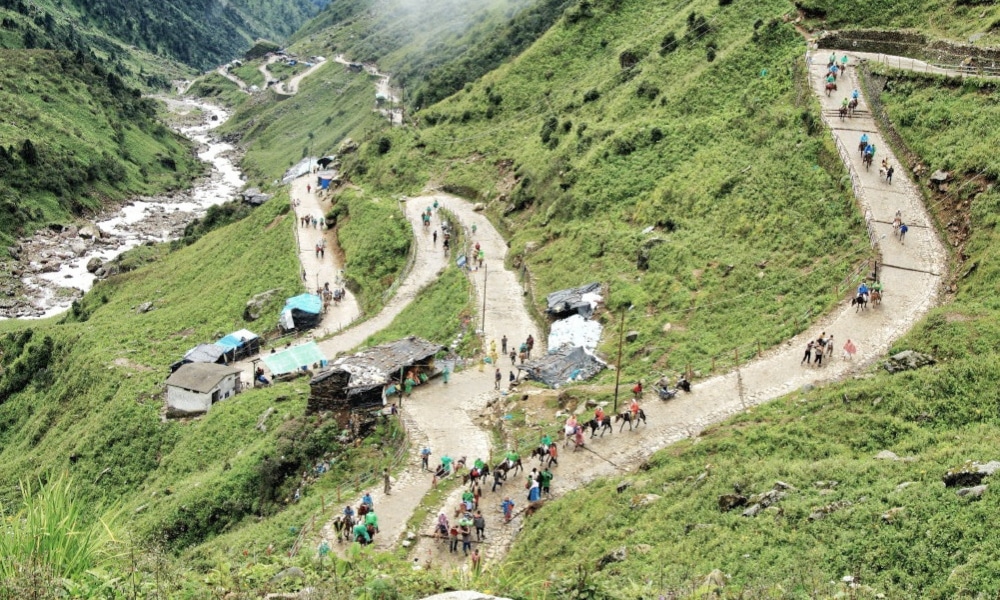
Char Dham Yatra Route Map: The Ultimate Guide for Pilgrims
The Char Dham Yatra Route Map is essential for planning the spiritual journey to four sacred sites in Uttarakhand: Yamunotri, Gangotri, Kedarnath, and Badrinath. This revered pilgrimage starts from Haridwar or Rishikesh and progresses through the Garhwal region in a clockwise direction, covering each of the holy dhams in sequence.
The route includes long drives and treks, such as the 18 km trek from Gaurikund to Kedarnath. Depending on preferences, the yatra can be undertaken by road, trekking, or helicopter. With proper planning, understanding of the Char Dham Yatra Route Map, and a focus on physical fitness, this spiritual journey becomes safe, fulfilling, and deeply rewarding.

Introduction to Char Dham Yatra
The Char Dham Yatra is a significant pilgrimage in Hinduism, believed to wash away sins and lead devotees towards salvation. Every year, millions of pilgrims undertake this spiritual journey to the four holy shrines, each located in the majestic Himalayas. The Char Dham Yatra Route Map is crucial for understanding the pathways and connections between these shrines, ensuring a well-organized pilgrimage.
The four sacred sites on the Char Dham Yatra are:
Yamunotri
- Dedicated to Goddess Yamuna, Yamunotri is the first dham on the Char Dham circuit. Located at an altitude of 3,293 meters, Yamunotri is the source of the River Yamuna. The trek to Yamunotri starts from Janki Chatti and is approximately 6 kilometers long. The temple, surrounded by natural hot springs, is believed to cleanse devotees of their sins. Surya Kund, a hot spring near the temple, is a popular spot where pilgrims cook rice and potatoes as offerings to the deity. The journey to Yamunotri is filled with scenic views of snow-capped peaks and dense forests.
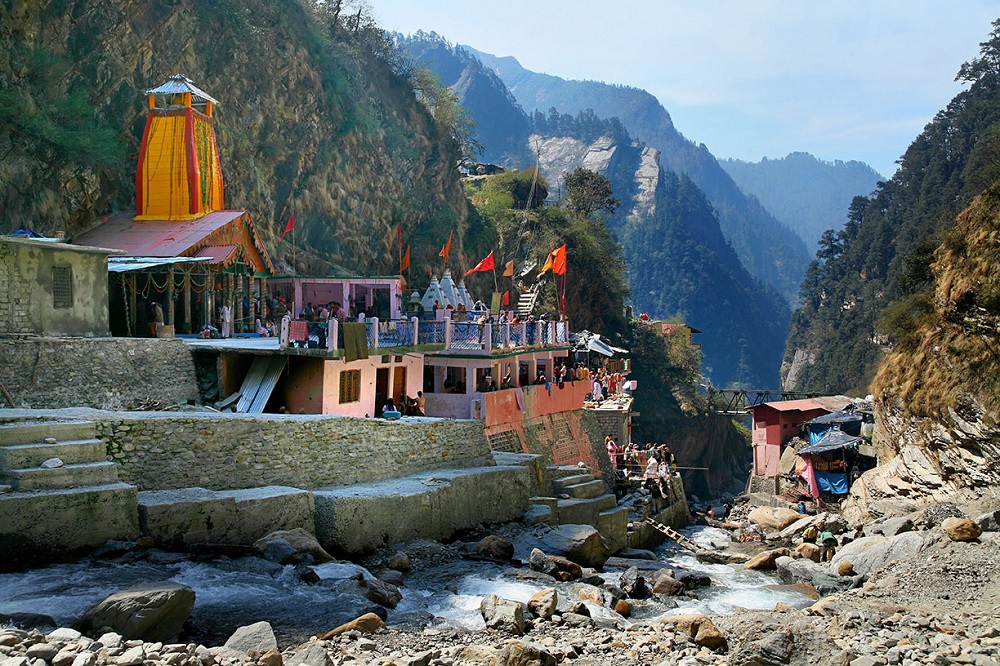
Gangotri
- The second dham on the route is Gangotri, dedicated to Goddess Ganga. Situated at an altitude of 3,100 meters, Gangotri marks the origin of the holy River Ganga. The temple, built by the Gorkha general Amar Singh Thapa in the 18th century, is an important place of worship for Hindus. The journey to Gangotri from Yamunotri is approximately 230 kilometers by road. Pilgrims also visit Bhagirathi Shila, a sacred stone near the temple where King Bhagirath meditated to bring Ganga to earth. The drive to Gangotri is a memorable experience with spectacular views of the Bhagirathi River and the surrounding mountains.
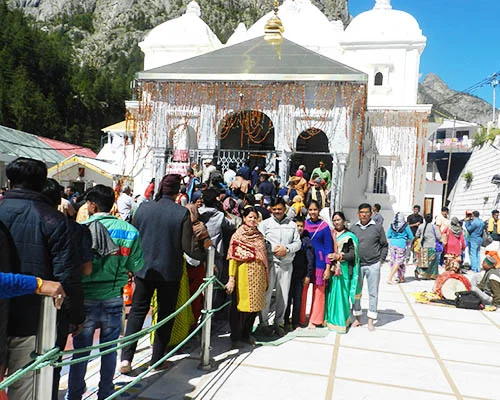
Kedarnath
- The third dham is Kedarnath, dedicated to Lord Shiva. It is one of the twelve Jyotirlingas and is considered one of the holiest pilgrimage sites for Shiva devotees. Located at an elevation of 3,583 meters, Kedarnath is surrounded by the majestic Kedarnath Peak. The trek to Kedarnath begins from Gaurikund, covering 18 kilometers of challenging terrain. Pilgrims can opt for ponies, palkis, or even helicopter services to reach the temple. According to Hindu mythology, the temple was built by the Pandavas to atone for their sins after the Mahabharata war. The Bhairavnath Temple, located near Kedarnath, is also a significant site as Bhairavnath is believed to be the protector of the Kedarnath Temple.
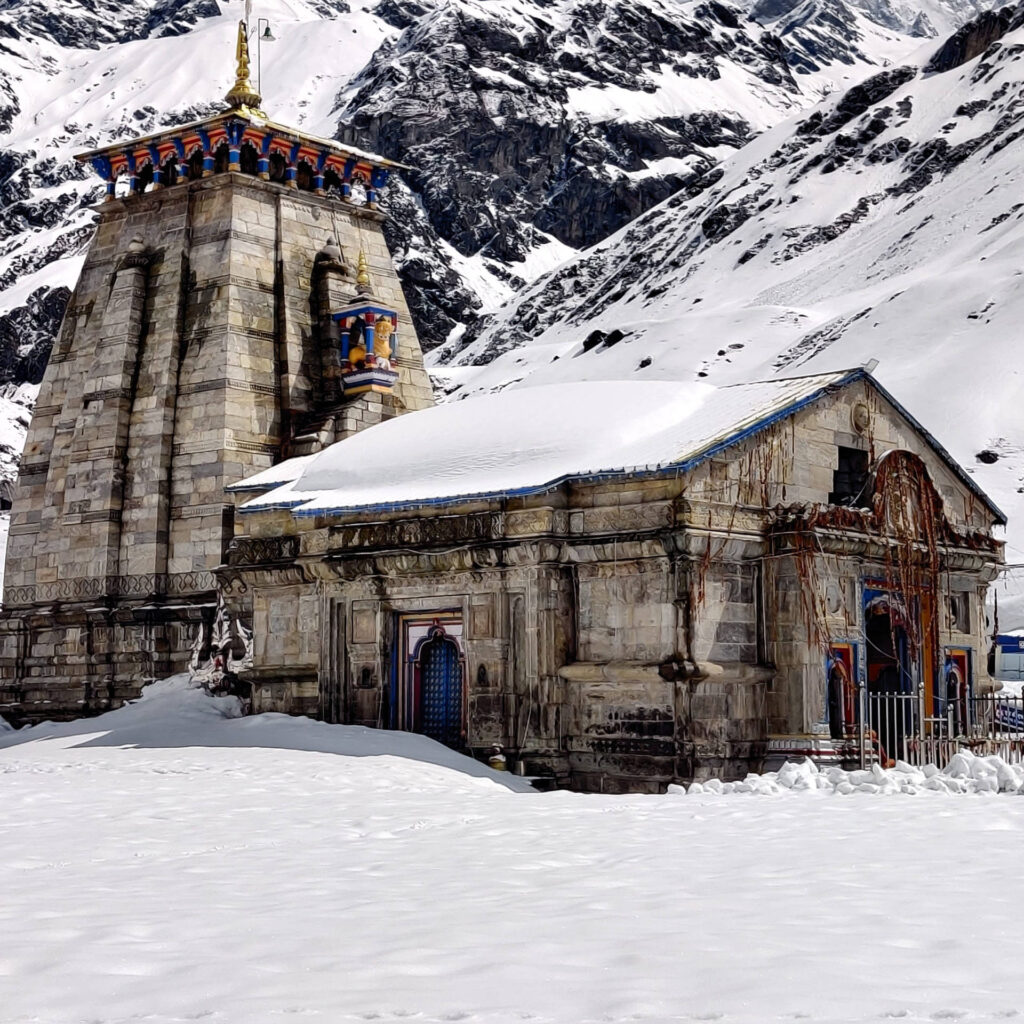
Badrinath
- The final dham on the Char Dham circuit is Badrinath, dedicated to Lord Vishnu. Situated at an altitude of 3,133 meters, Badrinath is one of the most important pilgrimage sites for Vaishnavites. The temple, located between the Nar and Narayan mountain ranges, is believed to have been established by Adi Shankaracharya in the 8th century. The Neelkanth Peak provides a stunning backdrop to the temple. Before visiting the temple, pilgrims take a dip in the Tapt Kund, a hot water spring believed to have medicinal properties. The temple remains open from April/May to November, depending on weather conditions.
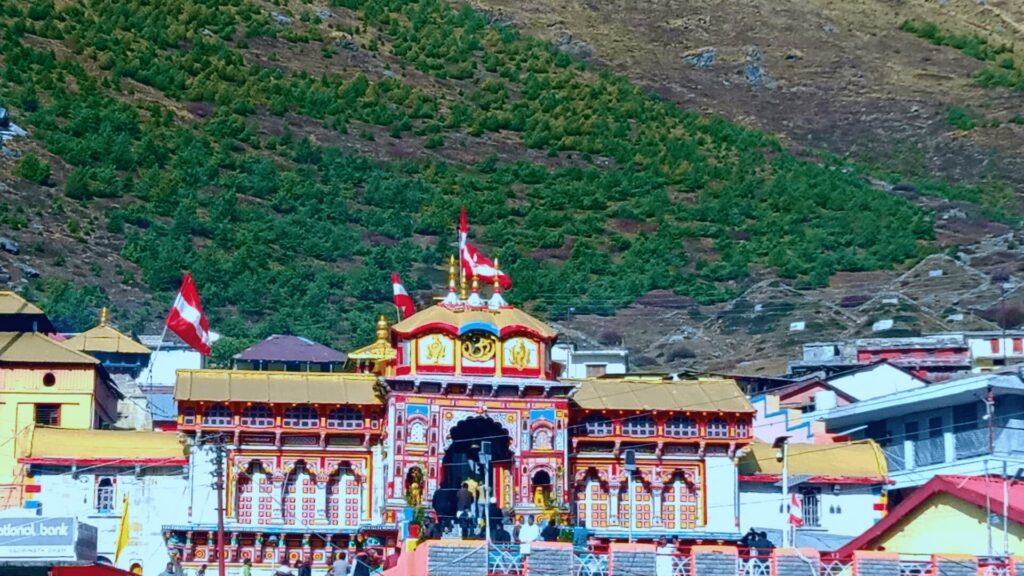
Char Dham Yatra Route Overview
The traditional Char Dham Yatra Route Map begins from Haridwar or Rishikesh in Uttarakhand. From here, the yatra progresses through the Garhwal region, covering each of the four dhams in sequence. The typical order is Yamunotri, Gangotri, Kedarnath, and finally Badrinath. This order is considered auspicious as it follows the clockwise direction, also known as the Parikrama route.
- Yamunotri: This is the first stop on the Char Dham Yatra. The trek to Yamunotri starts from Janki Chatti, which is accessible by road.
- Gangotri: The journey continues to Gangotri, which is accessible by a motorable road leading to the temple dedicated to the Goddess Ganga.
- Kedarnath: The Kedarnath trek is one of the most challenging parts of the Char Dham Yatra. Pilgrims need to trek 18 km from Gaurikund to reach the Kedarnath Temple.
- Badrinath: The final stop on the route is Badrinath, a temple dedicated to Lord Vishnu. Badrinath is accessible by road, making it easier for pilgrims to complete their yatra.
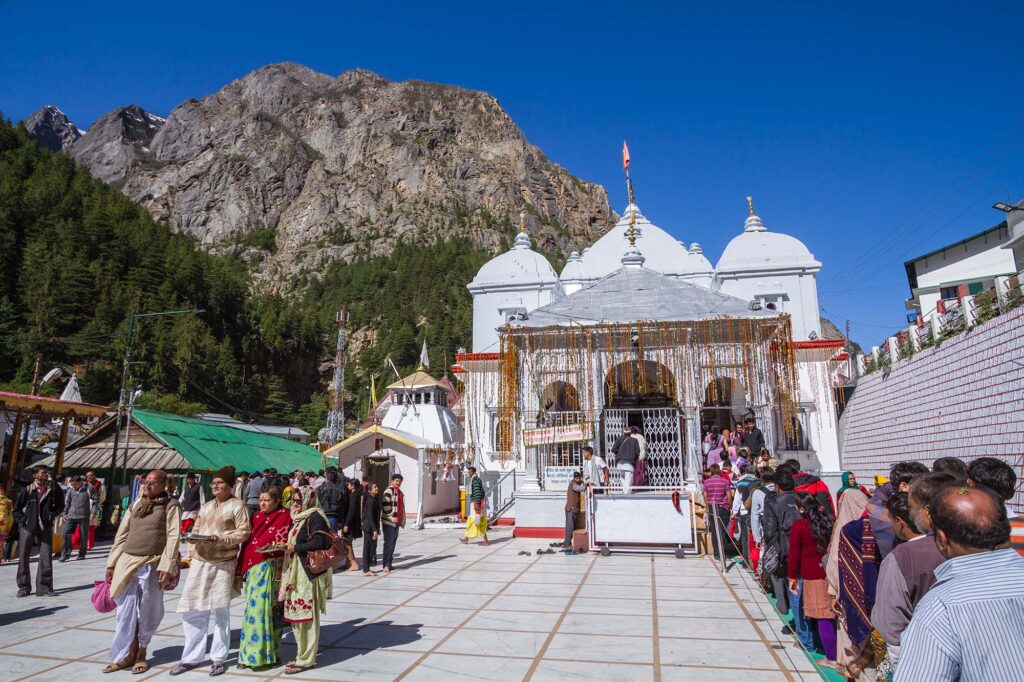
Char Dham Yatra Route Map Details
Understanding the Char Dham Yatra Route Map is essential to efficiently plan your pilgrimage, especially for first-time visitors. The entire route can be divided into segments, which can be navigated by road, trekking, or using helicopter services. Let’s explore each segment in detail.
- Haridwar/Rishikesh to Yamunotri
- Distance: Around 220 km to Janki Chatti.
- Travel Time: 8-10 hours by road.
- Trekking Distance: 6 km from Janki Chatti to Yamunotri Temple.
- Highlights: Scenic views of the Yamuna River and snow-capped peaks.
- Yamunotri to Gangotri
- Distance: Approximately 230 km by road.
- Travel Time: 9-10 hours.
- Highlights: Drive along the banks of the Bhagirathi River and enjoy the scenic beauty of the Himalayan ranges.
- Gangotri to Kedarnath
- Distance: About 270 km to Gaurikund.
- Travel Time: 12-13 hours by road.
- Trekking Distance: 18 km from Gaurikund to Kedarnath Temple.
- Highlights: Experience the beauty of the Mandakini River and the majestic Kedarnath peak.
- Kedarnath to Badrinath
- Distance: Around 220 km by road.
- Travel Time: 9-10 hours.
- Highlights: Pass through Rudraprayag, the confluence of the Alaknanda and Mandakini rivers.
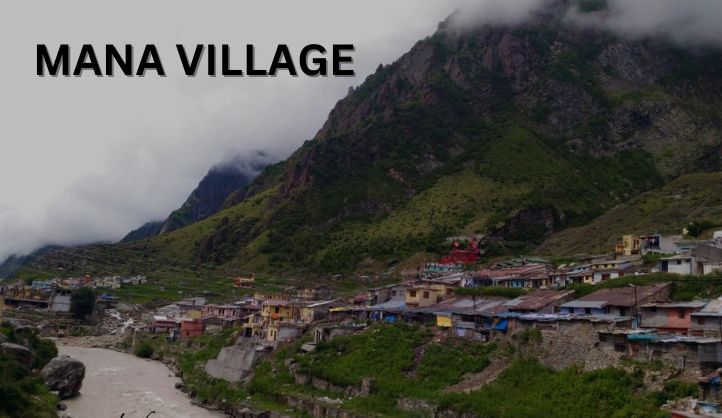
Modes of Transportation on the Char Dham Yatra Route
The Char Dham Yatra Route Map can be covered through various modes of transportation, depending on the preferences and physical capabilities of the pilgrims:
- By Road: Most of the route is well connected by motorable roads. Pilgrims can hire taxis, private vehicles, or opt for government-run bus services.
- By Trekking: Some portions, such as the trek from Gaurikund to Kedarnath, must be done on foot or using services like ponies, palkis, or palanquins.
- By Helicopter: Helicopter services are available for those who wish to complete the Char Dham Yatra quickly and without the strain of trekking. Helicopter packages are available for all four shrines, making it accessible for elderly and physically challenged devotees.
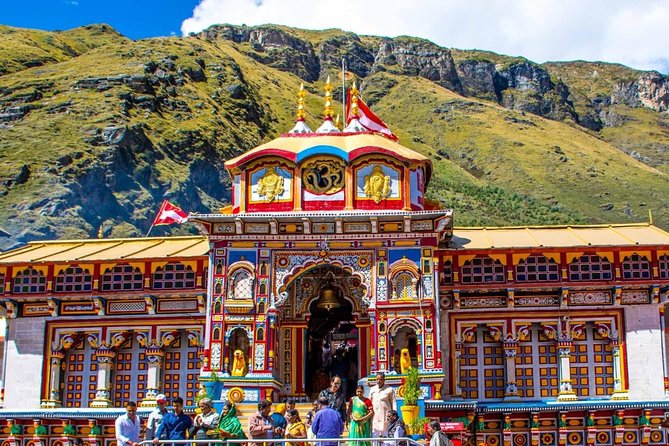
Char Dham Yatra Travel Tips
To ensure a safe and comfortable pilgrimage, here are some important travel tips for undertaking the Char Dham Yatra:
- Physical Fitness: The yatra involves a significant amount of trekking, especially to Kedarnath and Yamunotri. It is advisable to maintain a good level of fitness before starting the journey.
- Travel Permits: Register for the Char Dham Yatra before starting the journey. Registration can be done online or at designated centers in Uttarakhand.
- Weather Conditions: The weather in the Himalayas can be unpredictable. Always check the weather forecast before embarking on the trek, and carry necessary warm clothing.
- Accommodation: Accommodation options are available at different points along the Char Dham Yatra Route. It is advisable to book in advance, especially during the peak season.
- Essential Items: Carry essential items like first aid kits, comfortable trekking shoes, raincoats, and enough snacks and water.
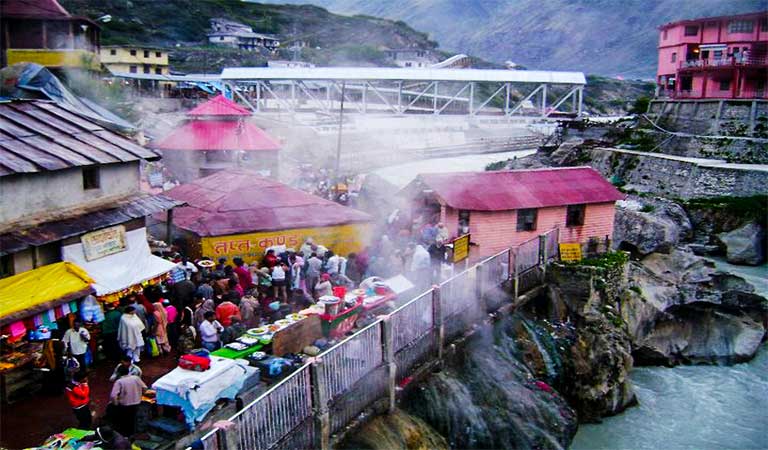
Places to Visit Along the Char Dham Route
The Char Dham Yatra Route Map not only includes the four sacred shrines but also several beautiful locations that you can visit along the way:
- Haridwar and Rishikesh: The gateways to the Char Dham Yatra, these cities are famous for their ghats, evening aarti, and ashrams.
- Barkot: Located en route to Yamunotri, Barkot is known for its stunning views of the Bandarpunch peak.
- Harsil: A charming village near Gangotri, known for its natural beauty and apple orchards.
- Guptkashi: Located on the way to Kedarnath, Guptkashi is famous for the ancient Vishwanath Temple and Ardhnarishwar Temple.
- Joshimath: A significant stop before reaching Badrinath, Joshimath is known for the Adi Shankaracharya Math and serves as the winter seat of Lord Badri.
- Vishnuprayag, Nandprayag, Karnaprayag, Rudraprayag, and Devprayag: The five sacred confluences of rivers (Panch Prayag) are important stops on the journey, where pilgrims can witness the confluence of holy rivers. Each confluence holds great spiritual importance and adds depth to the Char Dham Yatra experience.
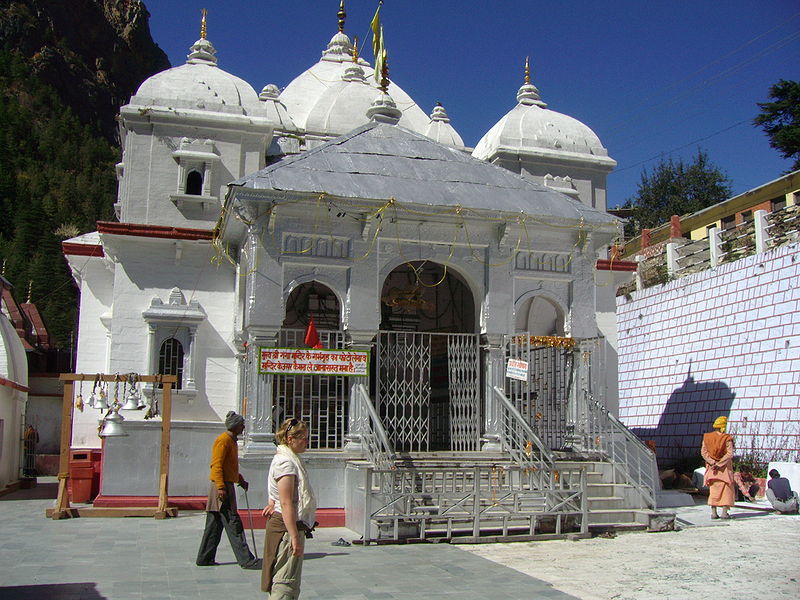
Significance of Each Dham
- Yamunotri: It is believed that a visit to Yamunotri, the source of the Yamuna River, helps devotees cleanse themselves of their sins and provides protection from an untimely death. The Yamunotri Temple is located at the foot of the Kalind Parvat. The thermal springs at Surya Kund near Yamunotri are also considered sacred, and pilgrims often cook rice and potatoes in the hot water as an offering to the goddess.
- Gangotri: The Gangotri Temple marks the origin of the River Ganga, which is revered as a goddess in Hindu mythology. It is believed that taking a dip in the sacred waters here purifies the soul. The Bhagirathi Shila, a sacred stone near the temple, is believed to be the site where King Bhagirath meditated to bring the Ganga down to earth.
- Kedarnath: The Kedarnath Temple, dedicated to Lord Shiva, is one of the twelve Jyotirlingas and holds immense significance for Shiva devotees. The temple is located against the backdrop of the majestic Kedarnath Peak. According to legend, the temple was built by the Pandavas to atone for their sins after the Mahabharata war. The Bhairavnath Temple, located near Kedarnath, is also a must-visit, as Bhairavnath is considered the protector deity of the Kedarnath Temple.
- Badrinath: The Badrinath Temple is dedicated to Lord Vishnu and is one of the most important pilgrimage sites for Vaishnavites. It is believed that a visit to Badrinath helps devotees attain moksha (liberation). The temple is situated between the Nar and Narayan mountain ranges, with the Neelkanth Peak providing a stunning backdrop. The Tapt Kund, a hot water spring near the temple, is considered sacred, and pilgrims take a dip here before entering the temple.
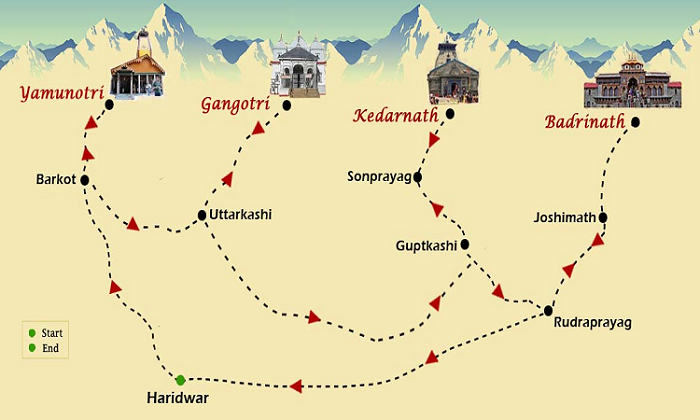
Helicopter Services for Char Dham Yatra
The helicopter service for the Char Dham Yatra is an excellent option for those who cannot undertake the rigorous journey by road and on foot. These services are available from various points, including Dehradun, Phata, Guptkashi, and Sersi. The helicopter packages are designed to cover all four dhams in just 2-3 days, providing a quick and comfortable way for pilgrims to complete their yatra.
- Booking Helicopter Services: It is advisable to book helicopter services well in advance, as there is high demand, especially during the peak season. Several private operators offer packages that include transfers, VIP darshan, and accommodation.
- Helipad Locations: Helipads are available at convenient locations near each dham. For Kedarnath, the helipad at Phata or Guptkashi is commonly used. For Badrinath, there is a helipad located close to the temple.
- Benefits of Helicopter Yatra: The helicopter yatra is ideal for elderly pilgrims or those with physical limitations. It significantly reduces travel time, allowing pilgrims to complete the entire Char Dham Yatra in just a few days.
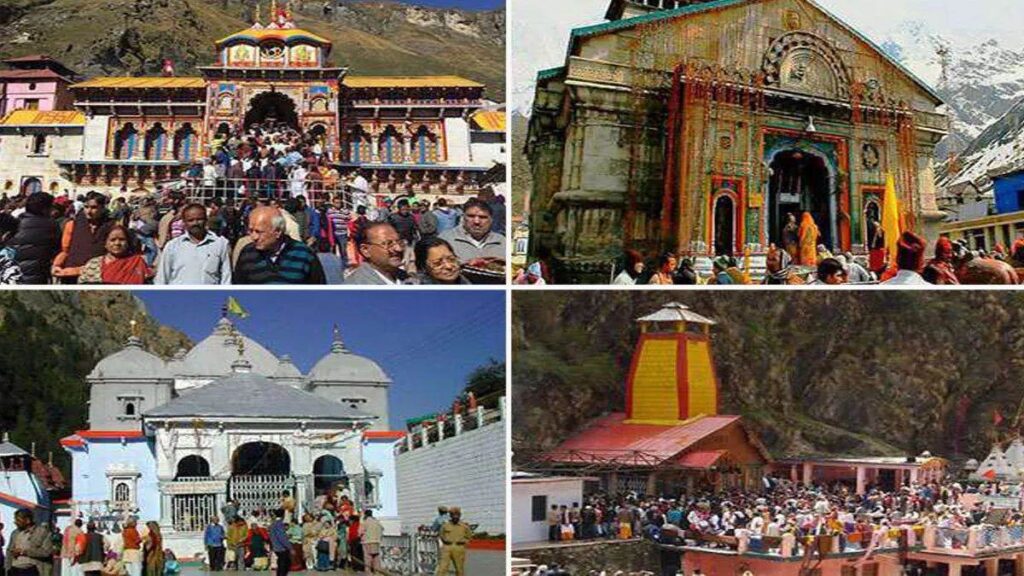
Char Dham Yatra by Road: Detailed Route Map
The Char Dham Yatra Route Map by Road typically starts from Haridwar or Rishikesh. Here is a detailed overview of the route:
- Haridwar to Barkot: The journey begins from Haridwar to Barkot (approx. 210 km). Barkot serves as the base for the Yamunotri trek.
- Barkot to Yamunotri: Drive from Barkot to Janki Chatti (approx. 36 km) and then trek 6 km to reach Yamunotri.
- Barkot to Uttarkashi: After visiting Yamunotri, drive to Uttarkashi (approx. 80 km), which serves as the base for the Gangotri trek.
- Uttarkashi to Gangotri: Drive from Uttarkashi to Gangotri (approx. 100 km) and visit the Gangotri Temple.
- Uttarkashi to Guptkashi: The next journey is from Uttarkashi to Guptkashi (approx. 220 km), which is the base for the Kedarnath trek.
- Guptkashi to Kedarnath: Drive from Guptkashi to Gaurikund (approx. 30 km) and trek 18 km to reach Kedarnath.
- Guptkashi to Badrinath: After Kedarnath, drive to Badrinath (approx. 220 km).
- Badrinath to Haridwar: Finally, drive from Badrinath back to Haridwar (approx. 320 km) to complete the yatra.
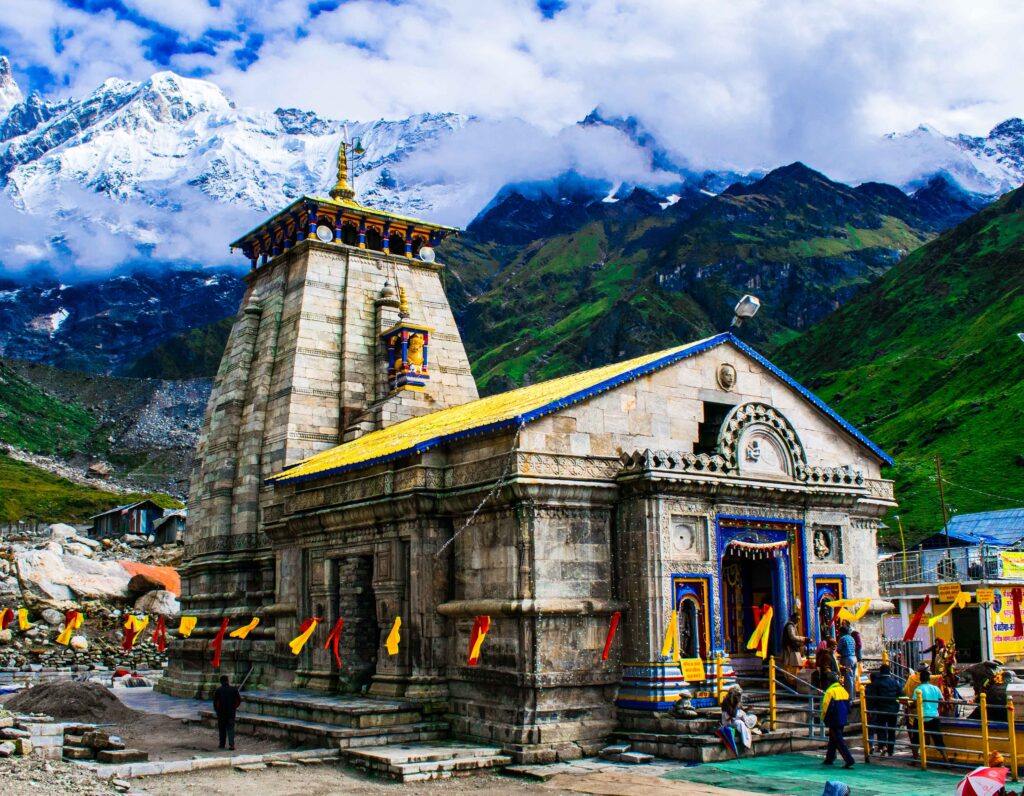
Char Dham Yatra Registration and Permits
The Char Dham Yatra requires pilgrims to register and obtain permits. Registration can be done online through the official Uttarakhand Tourism website or at designated counters in Haridwar, Rishikesh, and other major towns. The registration process helps authorities keep track of pilgrims for safety purposes and ensures a smooth yatra experience.
- Biometric Registration: Biometric registration is mandatory for all pilgrims undertaking the Char Dham Yatra. This can be done at various centers in Uttarakhand. Pilgrims need to provide identification details, and they will receive a registration card, which must be carried throughout the journey.
- E-Pass: An e-pass is also required for visiting each dham. The e-pass can be obtained online, and it helps manage the flow of pilgrims, especially during peak times.
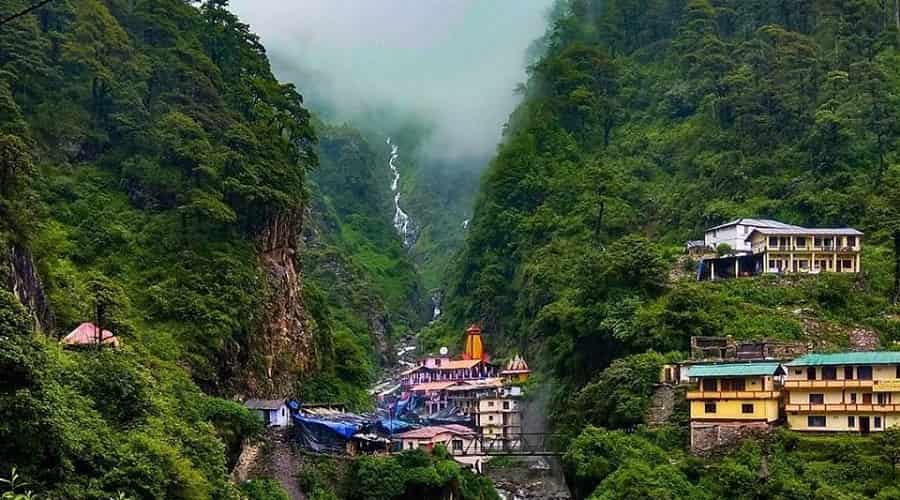
Best Time to Undertake the Char Dham Yatra
The Char Dham Yatra is generally undertaken between April/May to October/November, with the temples opening during Akshaya Tritiya in April/May and closing after Diwali in October/November. The best time to visit is during the summer months of May to June and the post-monsoon period from September to October, when the weather is relatively stable, and the roads are accessible.
- Summer (May to June): This is considered the best time for the yatra, as the weather is pleasant, and the roads are generally clear. It is also the peak season, so expect a large number of pilgrims.
- Monsoon (July to August): The monsoon season can be challenging due to heavy rainfall, which may cause landslides and roadblocks. Pilgrims are advised to be cautious and check weather updates before planning their journey during this time.
- Post-Monsoon (September to October): The post-monsoon period is another good time to undertake the yatra, as the weather is cool, and the region is lush and green after the rains. The crowd is also comparatively lesser than in the peak summer season.
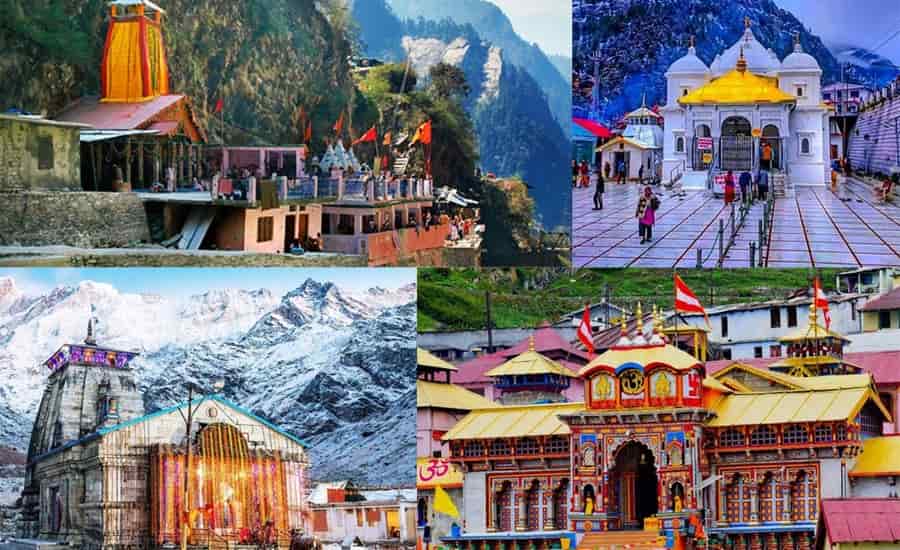
Medical Facilities and Safety Measures
Given the challenging terrain and high altitudes involved in the Char Dham Yatra, it is essential to be aware of the medical facilities and safety measures in place:
- Medical Camps: Medical camps are set up at various points along the Char Dham Yatra Route to provide first aid and emergency care to pilgrims. These camps are equipped with basic medical facilities, and doctors are available to attend to any health issues that may arise during the journey.
- High Altitude Precautions: Some of the dhams, particularly Kedarnath and Badrinath, are located at high altitudes. Pilgrims may experience symptoms of altitude sickness, such as headache, nausea, and shortness of breath. It is advisable to take things slow, stay hydrated, and rest whenever needed.
- Local Authorities and Police: The local authorities and police are present throughout the route to assist pilgrims and ensure their safety. In case of any emergencies, pilgrims can seek help from the nearest police station or check-post.
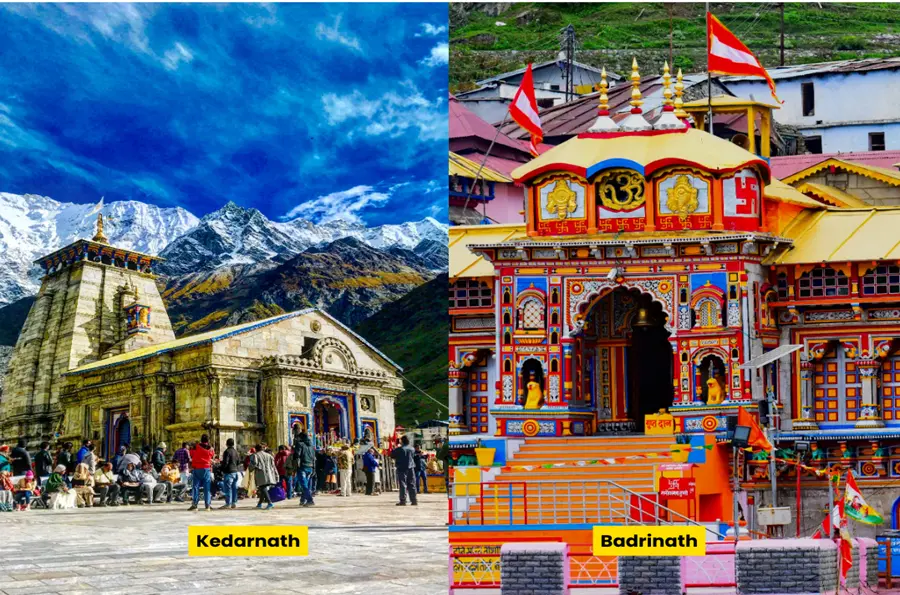
Environmental Responsibility During the Yatra
The Char Dham Yatra passes through some of the most ecologically sensitive regions in the Himalayas. It is important for pilgrims to practice responsible tourism to help preserve the natural beauty and ecological balance of the region.
- Avoid Littering: Carry a small bag for waste and dispose of it responsibly. Do not throw plastic bottles, wrappers, or other non-biodegradable items along the trekking routes or near the temples.
- Respect Local Culture: The local communities in Uttarakhand are deeply connected to their culture and traditions. Be respectful towards the locals, follow their customs, and seek permission before taking photographs of people or their property.
- Stick to Designated Paths: While trekking, always stick to the designated paths and avoid taking shortcuts. This helps in preserving the natural flora and fauna and ensures safety for all pilgrims.

Conclusion
The Char Dham Yatra Route Map serves as a guide for pilgrims to navigate the sacred journey to Yamunotri, Gangotri, Kedarnath, and Badrinath. Whether you choose to undertake this yatra by road, trek, or helicopter, the journey promises spiritual growth, breathtaking natural beauty, and a deep connection with the divine. By planning your trip meticulously and understanding the Char Dham Yatra Route, you can make your pilgrimage safe, fulfilling, and memorable.
This guide provides a comprehensive overview of the CharDham Yatra Route Map, highlighting routes, transportation options, travel tips, and important places along the way. Whether you’re planning to embark on this journey for religious reasons or simply to experience the pristine beauty of the Himalayas, the Char Dham Yatra is an experience like no other. With the right preparations, the blessings of the divine, and respect for the environment, your journey will be an unforgettable adventure filled with devotion and discovery.








Leave a Reply